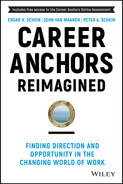6
Career Anchors Assessment: A Preview of the Online Experience
Dr. Seuss:
“On and on you will hike
And I know you'll hike far
And face up to your problems
Whatever they are.”
It is our hope that you will work through the Career Anchors assessment and realize the opportunities to leverage your strengths and move beyond what you feel are “problems” in your career trajectory.
The online assessment, https://www.careeranchorsonline.com, that accompanies this book offers an easy way for you to test your insights about yourself with a set of questions derived from the original longitudinal Career Anchors study.
We have ordered the self‐insight exercises so far—reflection, relationship mapping, the partner/personal interview, and now the assessment so that you have multiple perspectives on your career journey.
The first part of the online assessment consists of 32 questions for which you score your reaction, whether in alignment or disagreement with the sentiment expressed in the statement.
Examples of the kinds of statements that you will score are as follows:
- I have always felt most successful and accomplished when I could use my specialized training/expertise in my work.
- I am always on the lookout for ideas that motivate me to start my own business.
- Being a general manager is more attractive to me than being an expert in a particular technical domain.
You will gauge your agreement with the sentiment along the following scale:
“I feel this way or agree with this sentiment …”
| 0 | Never |
|---|---|
| 1 | Seldom |
| 2 | Often |
| 3 | Always |
There are 32 items in this format. It takes about 10–15 minutes to go through and react to all of the items. You may start to see a pattern in the kinds of statements, but do not let that distract you. The idea is to react to each of the items individually, and then let the online system put them together into your pattern.
Your pattern will represent preferences or leanings in your career choices around the eight anchors that we have described. Rather than simply rank‐ordering these preferences, we provide a graphical representation of your preferences for the anchors. The graphical representation is in a “spiderweb,” or “radar” chart format.
The numbers that will appear on the vertical scale of the emergent anchors chart are simply the result of arithmetic to measure relative importance of each anchor. Keep in mind that it is the pattern of the lines that matters, not the numerical scores per se.
To help you interpret your own career “spiderweb,” we provide the following example from one of our career journeys described in the previous chapter.
Recall Jamal, who worked for the Seattle Police Department. What insights would Jamal gain from taking the 32‐item Career Anchors assessment?

Exhibit 6.1 Jamal's Career Anchors
Jamal's Career Anchors pattern suggests a number of things about his work preferences: He puts a high priority on Service, he values his Technical‐Functional base, and has little interest in General Management. Jamal shows a balanced strong interest in Stability and Life‐Work Integration, which may reflect the fact that Jamal has been through career transitions and has found that he needs to honor his family's needs in his career journey. Seeking Security in his career is part of this realization. Jamal does have a leaning toward Challenge and Risk, particularly of the physical sort—recall that he joined a SWAT team and has pursued outdoor guide challenges in his later career. Perhaps most interesting in this is that Jamal is showing a leaning toward Autonomy that may not have been as prominent when he was a police officer working for a large city PD. It is certainly possible to lean toward Autonomy and Service simultaneously.
The Career Anchors charts array the eight anchors across from each other, but these should not be thought of as polarities per se. Any pattern, any blending of career preferences is possible. The career anchors items are designed to explore your preferences from different angles, different phrasings that will trigger different reactions. One way or the other, your impression of your Career Anchors chart will likely be one of surprise, delight, confirmation, and possibly disappointment. Regardless, it should be taken in the spirit of learning. Whether Jamal agrees with his “spiderweb” or not, he will learn something from it.
Your Own Career Anchors Profile
It's now time to create your own baseline career anchors preferences. So go online and create your own spiderweb. On visual inspection, does this align with your expectations? Are you surprised? If you did the interview with a partner or solo, were you expecting to see preferences clustered where they were, or were you thinking your preferences would present a different picture? And if you did the interview with another person, we would urge you to have a discus‐sion with the same person who interviewed you about your Career Anchors chart. Does it fit the interviewer's sense of your career preferences?
You should hold on to the chart for reference when you are thinking about the pros and cons of your current position and what really matters to you. When you are asked to describe yourself, your strengths, and weaknesses, the visual should be both memorable and helpful.
